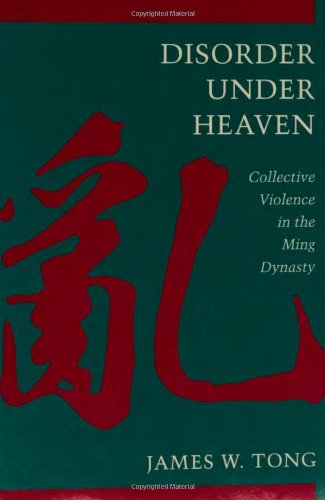Disorder Under Heaven: Collective Violence in the Ming Dynasty - Hardcover

A monumental study of collective violence in the premodern world, this book analyzes all instances of rebellion and banditry recorded in 1,097 counties in China during the 277 years of the Ming dynasty (1368-1644). The assembled evidence constitutes the largest annual, county-level time-series on collective violence events in any part of the world, and the 630 recorded cases are used to test the major social science theories on the origins of collective violence.
Using systematic data collected from local gazetteers on natural calamities, size of harvests, famine relief, physical terrain, local construction, and troop deployment, the author advances and validates a rational-choice argument that violence increased when survival in a subsistence economy became uncertain and the likelihood of punishment was low. Analyzing the administrative effectiveness and coercive capacity of the Ming state, the author also finds evidence to support a complementary structuralist explanation for increased collective violence in times of lax rulers, state insolvency, and inadequate tax policies.
After an introductory chapter, the author explicates the main theoretical and methodological issues of collective violence and sketches the empirical pattern of rebellions and banditry, differentiating them by the level of threat they posed to the regime and by the sociopolitical profile of participating groups.
In the next four chapters, he relates the Ming empirical configuration to four theoretical frameworks for collective violence: rational choice, which includes the issue of motive and choice--why people chose to become bandits; opportunity, in which the level of Ming collective violence is related to variations in a regime's coercive capacity; social change, which is used to shed light on food riots, anti-tax rebellions, and conflicts between employers and employees and between natives and outsiders; and class conflict, which prompts the author to assess the Marxist explanation for collective violence by investigating revolts of commoners against imperial clansmen, bondservants against masters, and tenants against landlords. The final chapter presents the author's conclusions on why and how the people became outlaws in the Ming and points to questions for future research.
Using systematic data collected from local gazetteers on natural calamities, size of harvests, famine relief, physical terrain, local construction, and troop deployment, the author advances and validates a rational-choice argument that violence increased when survival in a subsistence economy became uncertain and the likelihood of punishment was low. Analyzing the administrative effectiveness and coercive capacity of the Ming state, the author also finds evidence to support a complementary structuralist explanation for increased collective violence in times of lax rulers, state insolvency, and inadequate tax policies.
After an introductory chapter, the author explicates the main theoretical and methodological issues of collective violence and sketches the empirical pattern of rebellions and banditry, differentiating them by the level of threat they posed to the regime and by the sociopolitical profile of participating groups.
In the next four chapters, he relates the Ming empirical configuration to four theoretical frameworks for collective violence: rational choice, which includes the issue of motive and choice--why people chose to become bandits; opportunity, in which the level of Ming collective violence is related to variations in a regime's coercive capacity; social change, which is used to shed light on food riots, anti-tax rebellions, and conflicts between employers and employees and between natives and outsiders; and class conflict, which prompts the author to assess the Marxist explanation for collective violence by investigating revolts of commoners against imperial clansmen, bondservants against masters, and tenants against landlords. The final chapter presents the author's conclusions on why and how the people became outlaws in the Ming and points to questions for future research.
"synopsis" may belong to another edition of this title.
- PublisherStanford University Press
- Publication date1992
- ISBN 10 0804716854
- ISBN 13 9780804716857
- BindingHardcover
- Edition number1
- Number of pages344
Buy New
Learn more about this copy
US$ 101.81
Shipping:
US$ 5.17
Within U.S.A.
Top Search Results from the AbeBooks Marketplace
DISORDER UNDER HEAVEN: COLLECTIV
Published by
Stanford University Press
(1992)
ISBN 10: 0804716854
ISBN 13: 9780804716857
New
Hardcover
Quantity: 1
Seller:
Rating
Book Description Condition: New. New. In shrink wrap. Looks like an interesting title! 1.4. Seller Inventory # Q-0804716854
Buy New
US$ 101.81
Convert currency

